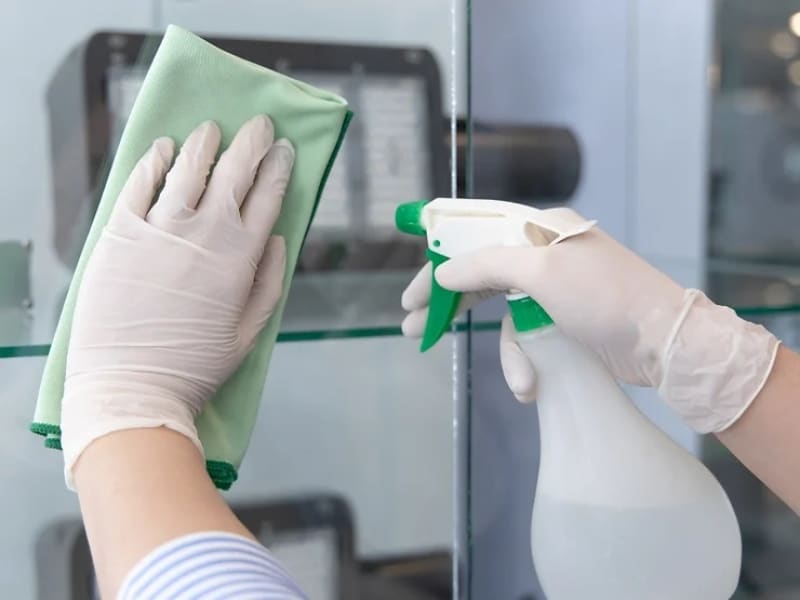How Do Banks Ensure Compliance With Cleaning Regulations?

Ensuring a bank maintains a clean and hygienic environment is crucial for customer satisfaction and regulatory compliance. Banks are held to high standards for cleanliness, as they provide services to the public in spaces where health, safety, and professionalism must be guaranteed. This article delves into how a bank ensures compliance with cleaning regulations and how janitorial services maintain these standards.
Why is it essential for banks to comply with cleaning regulations?
Compliance with cleaning regulations in banks isn’t just about keeping the premises neat; it’s about ensuring the environment meets specific health and safety standards. The following are key reasons why banks must adhere to cleaning regulations:
- Health and safety: One critical aspect is the impact of cleaning on indoor air quality. Regular cleaning helps to reduce dust, allergens, and harmful particles, promoting a healthier environment for both employees and customers.
- Customer trust: Customers expect a professional and sanitary environment. Failing to meet cleanliness standards can damage the bank’s reputation.
- Regulatory requirements: Banks are subject to numerous regulations, including those related to sanitation and cleanliness, which vary by location and type of service.
- Employee well-being: Ensuring the workplace’s cleanliness is vital for bank employees’ health and productivity.
What cleaning standards should banks meet to ensure compliance?
Bank cleaning must adhere to various compliance to meet health and safety regulations and customer expectations. Here’s a breakdown of the primary standards banks should follow:
- Sanitization of high-touch areas: To prevent the spread of germs, high-touch areas such as teller counters, ATMs, and door handles should be cleaned and sanitized regularly.
- Restroom hygiene: Clean, fully stocked, and well-maintained restrooms are essential for customer and employee satisfaction.
- Floor maintenance: Floors, especially in high-traffic areas like lobbies and hallways, need to be kept clean and free from hazards.
- Waste disposal: Proper disposal, including confidential documents, must be carried out to meet security standards.
- General cleanliness: The bank’s environment, including waiting areas and private offices, should be cleaned to create a welcoming space for customers and staff.
How do banks customize their cleaning schedules to meet regulatory standards?
Banks often tailor their cleaning schedules to meet the facility’s regulatory and operational requirements. Here’s how:
- Frequency of cleaning: Banks may require daily or weekly cleanings based on foot traffic, with high-traffic areas needing more frequent attention.
- After-hours cleaning: To avoid disrupting bank operations, cleaning can be scheduled during non-business hours, ensuring all surfaces are cleaned and sanitized without interruption.
- Deep cleaning: Periodic deep cleaning is necessary to ensure areas like carpets, floors, and upholstery are thoroughly sanitized and restored to their best condition. Furthermore, implementing effective carpet cleaning techniques for banks is essential to maintaining a professional appearance, reducing allergens, and creating a hygienic environment for customers and employees.
- Disinfection protocols: High-touch areas and frequently used surfaces should be disinfected daily to minimize contamination risk.

Why is it essential for banks to use eco-friendly cleaning solutions?
As part of their commitment to environmental responsibility, many banks are turning to eco-friendly cleaning solutions. Here’s why banks must incorporate these practices:
- Healthier work environment: Non-toxic and chemical-free cleaning products ensure that staff and customers are not exposed to harmful substances.
- Sustainability: Using environmentally friendly products helps banks contribute to sustainability and align with green building certifications.
- Public perception: Customers appreciate businesses that take steps to protect the environment. By choosing eco-friendly products, banks enhance their public image.
- Compliance with green standards: In many areas, green cleaning practices are part of the regulatory requirements for businesses, especially those with large public spaces.
What are the consequences of failing to meet cleaning compliance regulations in a bank?
Failing to meet cleaning compliance regulations can result in severe consequences for banks. Here’s a look at some potential repercussions:
- Fines and penalties: Banks may face fines for failing to meet health and safety standards set by local authorities.
- Damaged reputation: Poor cleanliness can result in negative customer reviews, damaging the bank’s reputation and eroding trust.
- Employee health issues: If the bank environment isn’t maintained to health standards, employees may suffer from illnesses, resulting in absenteeism and reduced productivity.
- Legal action: In extreme cases, poor sanitation can lead to lawsuits if customers or employees suffer from disease due to a lack of cleanliness.
How can janitorial services support compliance with bank regulations?
Professional janitorial services play a pivotal role in helping banks maintain compliance with cleaning regulations. Here’s how:
- Expert knowledge: Professional cleaning teams understand the specific cleaning needs of banks and stay updated on industry standards and regulations.
- Custom cleaning plans: Janitorial services tailor cleaning schedules to fit the bank’s needs, covering all areas, from high-touch surfaces to restrooms.
- Consistent monitoring: Regular cleaning and inspection ensure that the bank remains compliant daily.
- Disinfection and sanitization: Professional bank cleaning solutions disinfect high-risk areas, such as ATMs and counters, helping prevent germs from spreading.

How can banks monitor and evaluate the effectiveness of their cleaning services?
Monitoring and evaluating cleaning services ensures that a bank complies with regulations. Here’s how banks can assess the effectiveness of their cleaning:
- Regular inspections: Banks can conduct daily or weekly inspections to ensure cleanliness and compliance with health and safety standards.
- Feedback from staff and customers: Banks can gather feedback from employees and customers to identify areas that need more attention.
- Cleaning reports: Janitorial services can provide detailed reports outlining the work done, areas cleaned, and any potential issues or improvements.
- Third-party audits: Some banks may choose third-party audits to ensure that cleaning services meet regulatory and operational standards.
How can you ensure your bank is always compliant with cleaning regulations?
To ensure consistent compliance with cleaning regulations, banks can follow these steps:
- Choose professional cleaning services: partner with experienced janitorial services specializing in bank cleaning and familiar with the industry’s regulations.
- Establish regular cleaning schedules: Develop a customized cleaning plan that fits your bank’s needs and complies with local regulations.
- Monitor and evaluate: Regularly inspect and assess cleaning effectiveness to ensure continued compliance.
- Stay updated on regulations: Stay informed about changes in local health and safety regulations to ensure your cleaning practices are always up to date.
Ensure compliance with JBM Janitorial’s bank cleaning services
JBM Janitorial understands the importance of regulatory compliance and offers tailored cleaning solutions designed for banks. From eco-friendly products to customized cleaning schedules, our team is committed to providing high-quality services that meet your bank’s needs.
To ensure your bank maintains the highest standards of cleanliness and compliance, partner with JBM Janitorial for expert bank cleaning tailored to your specific needs.
